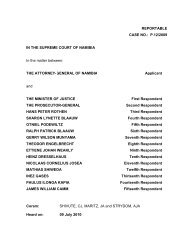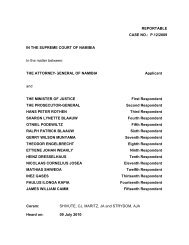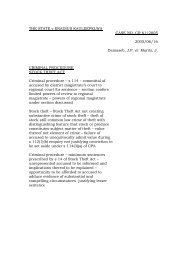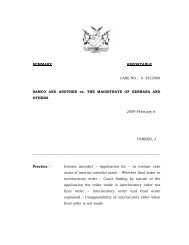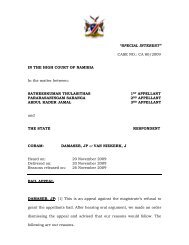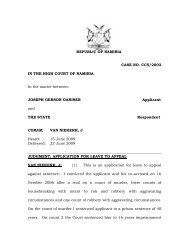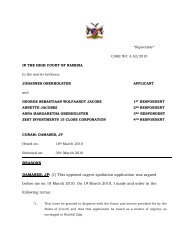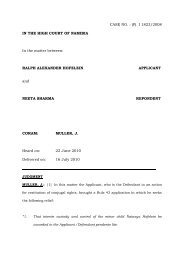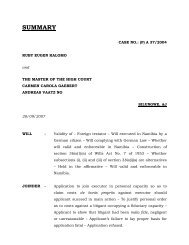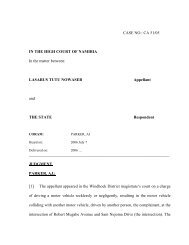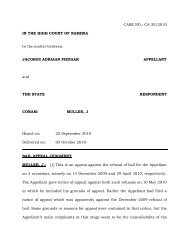Harry Simon vs The State - Superior Courts of Namibia
Harry Simon vs The State - Superior Courts of Namibia
Harry Simon vs The State - Superior Courts of Namibia
- No tags were found...
Create successful ePaper yourself
Turn your PDF publications into a flip-book with our unique Google optimized e-Paper software.
CASE NO.: CA 134/2005HARRY SIMON <strong>vs</strong> THE STATE2007 JULY 9PARKER, J; MANYARARA, AJCriminal law -Culpable homicide – Appellant’s motor vehicle colliding with another motor vehicleresulting in death <strong>of</strong> three occupants <strong>of</strong> that other motor vehicle – Appellantconvicted <strong>of</strong> culpable homicide – Magnitude <strong>of</strong> tragedy not to obscure true nature <strong>of</strong>culpability being negligent driving – Negligent driving – what amounts to – Factorstaken into account in arriving at appropriate sentence – Four years’ imprisonment,one-half <strong>of</strong> it suspended, imposed by lower court appropriate in all the circumstances– <strong>State</strong>’s appeal against sentence and the appellant’s appeal against conviction andsentence dismissed.
2REPORTABLE CASE NO. CA 34/2005IN THE HIGH COURT OF NAMIBIAIn the matter between:HARRY SIMONAPPELLANTandTHE STATERESPONDENTCoram:PARKER, J; MANYARARA, A.J.Heard on: 2007 May 21-22Delivered on: 2007 July 9APPEAL JUDGMENT:PARKER, J; MANYARARA, A J:Introduction[1] <strong>The</strong> appellant appeared in the Regional Court at Walvis Bay on one count <strong>of</strong> culpablehomicide, with two alternative charges <strong>of</strong> reckless and/or negligent driving and inconsideratedriving, and a second count <strong>of</strong> exceeding the speed limit. He pleaded not guilty.[2] <strong>The</strong> court found that there was a duplication <strong>of</strong> charges in the count <strong>of</strong> exceeding thespeed limit and negligent driving and the trial proceeded in respect <strong>of</strong> the charge <strong>of</strong> culpable
3homicide only. <strong>The</strong> appellant was convicted on this charge and sentenced to four years’imprisonment <strong>of</strong> which two years are suspended. He appealed against the conviction andsentence and the <strong>State</strong> also appealed against the sentence as too lenient. An application toamend the notice <strong>of</strong> appeal by adding further grounds <strong>of</strong> appeal was subsequently filed,accompanied by an application for condonation <strong>of</strong> the late filing <strong>of</strong> the additional grounds.Ms Rakow for the <strong>State</strong> did not oppose the application, condonation was granted and thehearing on the merits proceeded.[3] <strong>The</strong> appellant has appealed against both the conviction and sentence, and the <strong>State</strong>against sentence. For the sake <strong>of</strong> neatness and completeness, this judgment deals with boththe appeal by the <strong>State</strong> and the appeal by the appellant.<strong>The</strong> Offence[4] <strong>The</strong> particulars <strong>of</strong> the <strong>of</strong>fence were that upon or about 21 November 2002 at or near themain road between Walvis Bay and Swakopmund at or near Langstrand the accused didunlawfully and negligently kill Ibe de Winter, Frederic de Winter and Michelle De Clerk bydriving his vehicle and colliding with the deceaseds' Nissan vehicle.[5] <strong>The</strong> particulars <strong>of</strong> negligence were enumerated as -• travelling at a speed which was excessive in the circumstances;• failing to keep a proper lookout in the circumstances;• failing to stop or act reasonably when an accident or collision seemed imminent; and• travelling on the wrong side <strong>of</strong> the road.[6] <strong>The</strong> relevant portion <strong>of</strong> the appellant's statement in terms <strong>of</strong> section 115(1) <strong>of</strong> theCriminal Procedure Act 51 <strong>of</strong> 1977 outlined his defence as follows:
4"<strong>The</strong> sole cause <strong>of</strong> the collision was the wrongful, unlawful and negligentdriving <strong>of</strong> the driver <strong>of</strong> the said Nissan vehicle who encroached, droveunexpectedly and suddenly into the lane wherein I drove, occasioning thecollision."[7] It will be seen that the defence defined the issues to be proved by the <strong>State</strong> as –(a) Whether the appellant drove negligently and, through his manner <strong>of</strong> driving, caused thedeaths <strong>of</strong> the deceased; or(b) Whether the vehicle in which the deceased were traveling suddenly encroached into theappellant’s path and, faced with the sudden emergency, the appellant had no opportunity<strong>of</strong> stopping or otherwise avoiding the collision.<strong>The</strong> Law[8] <strong>The</strong> elements <strong>of</strong> culpable homicide are set out in S v Burger 1975 (4) SA 877 (A), thehead note, as follows:"(i)Culpable homicide is the unlawful, negligent causing <strong>of</strong> the death <strong>of</strong> ahuman being.(ii)Basically there must be some conduct on the part <strong>of</strong> the accusedinvolving dolus (such as an assault), or culpa (such as an operation bya surgeon without due care, or the driving <strong>of</strong> a motor vehicle withoutkeeping a proper look-out).(iii)Such conduct must cause the death <strong>of</strong> the deceased.(iv)In addition there must be culpa in the sense that the accused oughtreasonably to have foreseen the possibility <strong>of</strong> death resulting from
5such conduct. This is because culpable homicide is the unlawful,negligent causing <strong>of</strong> the death <strong>of</strong> a human being.(v)It follows from the foregoing that causation <strong>of</strong> death, even as theresult <strong>of</strong> an unlawful act which is criminally punishable, is not <strong>of</strong> itselfsufficient to constitute the crime <strong>of</strong> culpable homicide. To disregardthe additional requisite <strong>of</strong> the reasonably foreseeable possibility <strong>of</strong>resultant death, would be to re-instate the doctrine <strong>of</strong> versari in reillicita.(vi) If an accused does foresee – as distinct from ought to have foreseen –the possibility <strong>of</strong> such resultant death and persists in his conduct withindifference to fatal consequence (or if he actually intends to kill) thecrime, would be that <strong>of</strong> murder. Having regard to the requirements <strong>of</strong>foresight and persistence, the dividing line between (a), murder withdolus eventualis and (b), culpable homicide, is sometimes ratherthin."[9] In S v Muhenje 1995 NR 133 (HC) Frank J stated the law at 134F as follows:“(I)t is exactly the negligence or recklessness in the driving <strong>of</strong> the vehiclewhich makes the killing unlawful, i.e. which constitutes an essential element <strong>of</strong>culpable homicide. <strong>The</strong> test relating to the negligence or recklessness where avehicle is involved is exactly the same for culpable homicide or for negligentor reckless driving.”And in Rex v Wells 1949 (3) SA 88 (A) Centlivres JA defined negligence at 88 as follows:"<strong>The</strong> test as to whether a person was guilty <strong>of</strong> negligence in any givencircumstances is the same in criminal as in civil proceedings, viz., did thatperson exercise that standard <strong>of</strong> care and skill which would be observed by
6the reasonable man? See Rex v Meiring (1944, A.D. 41, at p 46) and Rex vSwanepoel (1945, A.D. 444, at p 448). It is therefore germane to the presentenquiry to refer to civil as well as criminal cases.As pointed out by Watermeyer, C.J., in Stride v Reddin (1944, A.D. 162, at p172) read with the passage quoted from the judgment <strong>of</strong> Innes, C.J., in CapeTown Municipality v Paine (1923, A.D. 207), the question whether in anygiven situation a reasonable man would have foreseen the possibility <strong>of</strong> harmand governed his conduct accordingly, is one to be decided in each case upona consideration <strong>of</strong> all the circumstances. See, too, Cowan v Ballam (1945,A.D. 81, at pp. 86, 94, 95).[10] It seems to us, therefore, that the first stage <strong>of</strong> the enquiry whether the appellant’sconduct in this case is caught by the above principles is a consideration <strong>of</strong> the evidence <strong>of</strong>eyewitnesses, by which is meant the evidence <strong>of</strong> persons who witnessed the occurrence <strong>of</strong>the accident or were in the vicinity <strong>of</strong> the scene <strong>of</strong> the accident at the relevant time. This isalso the submission <strong>of</strong> Mr Sisa Namandje representing the appellant.<strong>The</strong> Evidence <strong>of</strong> Eye witnesses[11] <strong>The</strong> <strong>State</strong> led evidence from four persons who were present at the scene <strong>of</strong> the accident.<strong>The</strong>se were Melanie Moumiew and her mother Wilhemina Melani, Oneka Alcock and BertusCoene.[12] Melanie’s evidence is that she was a passenger in the car driven by Wilhemina. Whenthey approached the scene <strong>of</strong> the accident at Long Beach, the Nissan vehicle traveled just infront <strong>of</strong> them at a speed she described as ‘slowly’ approaching the T-junction where theaccident happened. She was sending an SMS on her cell phone but as they turned left toenter the overtaking slipway she looked up and saw a vehicle approaching at a great speed,overtake a green vehicle in front <strong>of</strong> it and immediately thereafter she heard a crash. She saidthat the green vehicle had to move out <strong>of</strong> the way to let the speeding vehicle pass.
7[13] Wilhemina gave evidence broadly to the same effect as Melanie. She added that as theywere approaching the turn <strong>of</strong>f to Langstrand the driver <strong>of</strong> the Nissan indicated that he wasgoing to turn right to Langstrand and stopped at a slight angle at the T-junction and shepassed the Nissan on its left side. She had not returned to the main road to Walvis Bay whenshe saw (car) lights pass her very fast and she heard the collision. Water splashed through theback window <strong>of</strong> their vehicle as well as her window. After the collision, she saw a blackvehicle standing in the sand and when she got to the vehicle she saw that it was <strong>Harry</strong> <strong>Simon</strong>,the appellant.[14] Alcock, the passenger in Wilhemina’s vehicle, also gave evidence broadly to the sameeffect as the above witnesses. Her evidence continued as follows:“I saw the indicators <strong>of</strong> the vehicle, I saw the brake lights before the turn <strong>of</strong>f,the bakkie was standing still and we passed by….I saw oncoming lights. Wepassed by and the car passed by speeding. <strong>The</strong> lights were very bright and itmade me feel as if the car was coming to us, towards us…because it was s<strong>of</strong>ast.”[15] Bertus Coene said that he was a passenger in the Nissan and they were on their way toLangstrand. <strong>The</strong>y stopped at the intersection in order to turn to Langstrand. <strong>The</strong>y might haveslightly turned but they stopped on their side <strong>of</strong> the road, i.e. in their lane. In the Nissan werefour grown-up persons and three children. He could only remember clearly that he saw oneset <strong>of</strong> (car) lights coming from the Walvis Bay direction and that is where his recollectionstopped. He suffered total amnesia after the accident.[16] Coene said that the Nissan was carrying two ro<strong>of</strong> tents, a 20 litre water tank, a bit <strong>of</strong> gasweighing between 9 and 10 kg, a table and three chairs; also some luggage and photographicequipment <strong>of</strong> one <strong>of</strong> the deceased, Frederic. He estimated the weight <strong>of</strong> these things at aminimum <strong>of</strong> 300kg. <strong>The</strong>re was also one spare wheel and “lots <strong>of</strong> fuel” in the Nissan.
8[17] In our view, nothing relevant turns on the quantity or weight <strong>of</strong> the contents <strong>of</strong> theNissan, save the 20 litre water tank because Melanie and Wilhemina spoke <strong>of</strong> water from theNissan splashing onto their vehicle.[18] <strong>The</strong> appellant did not testify or call any witnesses other than one expert whose evidencewill be considered.<strong>The</strong> Expert Evidence[19] <strong>The</strong> first <strong>of</strong> the experts called by the <strong>State</strong> was Johannes Petrus Strydom, by pr<strong>of</strong>essiona traffic accident analyst <strong>of</strong> about 27 years’ experience, during which period he attendedsome 1755 traffic accidents and assisted in the reconstruction <strong>of</strong> 6324 accidents.[20] He was instructed by Attorneys Wessels and Van Der Merve-Greef to re-construct theaccident and his evidence may be summarized as follows:[20.1] He testified that he visited the scene on 11 December 2003 and identified “the fourmost important factors” with regard to the analysis and reconstruction <strong>of</strong> trafficaccidents. <strong>The</strong>se were –a) <strong>The</strong> final resting positions <strong>of</strong> the vehicles.b) <strong>The</strong> damage to the vehicles, which shows the first contact areas<strong>of</strong> the vehicles when they collided.c) <strong>The</strong> debris found at the scene; andd) <strong>The</strong> marks on the road.He added that it was not necessary to have all four or more <strong>of</strong> these points to carry outa reconstruction.[20.2] <strong>The</strong> witness admitted that it is virtually impossible to pinpoint the exact point <strong>of</strong>impact – it could be a metre either side <strong>of</strong> the point identified. <strong>The</strong> little pieces <strong>of</strong>
9vehicle, plastic pieces, etc. which he found at the scene corresponded with andconfirmed the police sketch plan indicating the final resting positions <strong>of</strong> the vehicles.He said that even if he did not have any <strong>of</strong> the witness statements his conclusionswould have been the same[20.3] It was also Strydom’s opinion that the breakage <strong>of</strong> the cables which the Mercedeswent through at the scene <strong>of</strong> the collision, as well as the force used to take the poleswhich had been there from the ground before coming to a stop in the sand, indicatedthat the speed <strong>of</strong> the Mercedes was 180 km/h. This was much higher than the speed <strong>of</strong>156km/h which he had calculated on the basis <strong>of</strong> the scratch marks where the policeclaimed was the place <strong>of</strong> the impact.[20.4] Strydom examined the photographs <strong>of</strong> the vehicles and observed that the Nissansustained severe damage concentrated to the left side <strong>of</strong> the vehicle and the left fronttyre, with secondary damage all over the body <strong>of</strong> the vehicle. He observed thatcontact damage to the Mercedes was concentrated mostly to the right front and midcentre<strong>of</strong> the vehicle. <strong>The</strong> right front area was displaced towards the rear <strong>of</strong> thevehicle; the right front tyre and rim had sustained severe collision damage and theright front corner <strong>of</strong> the vehicle was pushed back very far. According to the witness,this showed that the collision was not a straight line <strong>of</strong> impact but at some sort <strong>of</strong>angle, and there was no probability that the Nissan had started to turn when thecollision occurred.[20.5] Strydom concluded that the Mercedes must have been in the wrong lane and, in hisopinion, the driver misjudged the distance he had to return to his correct lane.[20.6] He added that when traveling from Walvis Bay to Swakopmund there is a little dipfrom where one can see the ro<strong>of</strong>s <strong>of</strong> any vehicles at the intersection to Langstrandfrom a distance <strong>of</strong> about 200-220 metres.
10[20.7] His opinion was that, assuming that the driver <strong>of</strong> the Mercedes was observing thespeed limit <strong>of</strong> 80 km/h operating on this stretch <strong>of</strong> the road, he would have seen thevehicle turning to Langstrand and it would have taken him 69 metres to stop hisvehicle 151 metres before the intersection. And if he were traveling at 80 km/h, bythe time that the Mercedes reached the intersection the vehicle turning to Langstrandwould have been out <strong>of</strong> the way and cleared the intersection for the Mercedes to passsafely.[21] Wilma Badenhorst is an accident reconstruction expert, in which capacity she carriesout site inspections, compiles reports on how the collision occurred and gives evidencethereon in court. She was contacted by Dr Ludik <strong>of</strong> the National Forensic Science Institute <strong>of</strong><strong>Namibia</strong> (NFISI) to do a reconstruction <strong>of</strong> the accident and she visited the scene duringNovember 2003, accompanied by the investigating <strong>of</strong>ficer, Sgt Giovani B<strong>of</strong>felli who haddrawn the sketch plan produced in the trial.[22] Her report on the damage to the two vehicles involved in the accident was essentiallythe same as Strydom’s. Referring to photographs, all but one <strong>of</strong> which were taken by herself,some <strong>of</strong> the salient points she made may be enumerated as follows:[22.1] Signs <strong>of</strong> ground contact or sand were visible on the right hand side <strong>of</strong> theMercedes and the left hand side did not show any contact damage.[22.2] <strong>The</strong> Nissan was a four wheel drive 3-litre hardbody double cab vehicle. Itsustained severe contact damage to its left front. Various vehicle parts such asthe bumper bar, engine parts, sheet metal and all parts in that area <strong>of</strong> thevehicle until the mid front section and the left front wheel were displaced fartowards the back <strong>of</strong> the vehicle. A lot <strong>of</strong> “induced damage” was also visible tothe ro<strong>of</strong>, left hand side <strong>of</strong> the vehicle and the flap <strong>of</strong> the load bin which mayhave been caused by items on the rear <strong>of</strong> the load bin coming into contact withthe inside <strong>of</strong> the flap.
11[22.3] She explained that, at first contact, the force <strong>of</strong> one vehicle against anothervehicle begins to crush parts <strong>of</strong> the vehicle in the direction <strong>of</strong> the thrust.<strong>The</strong>refore, what one sees after a collision is damage which indicates thedirection and extent <strong>of</strong> penetration at maximum engagement and the areaswhich have been in contact with each other.[22.4] In order to get to first contact, one has to rotate the Nissan back relative to theMercedes and that is why the angle between the two vehicles at first contact isnot as large as the angle between them at maximum engagement.[22.5] From first contact to the point <strong>of</strong> maximum engagement, the Nissan wouldhave rotated clockwise relative to the Mercedes.[22.6] <strong>The</strong>re were four lanes at the scene. <strong>The</strong> most left hand lane <strong>of</strong> the northboundlanes and the most left hand lane <strong>of</strong> the southbound lanes were to be excludedas possibilities <strong>of</strong> where the collision occurred.[22.7] By her calculation, the momentum <strong>of</strong> the Mercedes would have been muchgreater than that <strong>of</strong> the Nissan; the Mercedes had a velocity component in anortherly as well as westerly direction only and all the momentum and energycame from this vehicle; so the final resting position must then have been alsoin a generally northerly and westerly direction and the marks on the roadsurface corresponded with this scenario.[22.8] According to what the witness described as “the law <strong>of</strong> conversion <strong>of</strong>momentum,” the total momentum which existed after the collision must havebeen present before the collision. By applying a mathematical formula toointricate to summarise, Badenhorst arrived at a speed <strong>of</strong> 159 km/h for theMercedes, if the Nissan were stationary. If the Nissan was in motion, it alsohad a velocity component and then the speed <strong>of</strong> the Mercedes would havebeen greater.
12[22.9] In Badehorst’s opinion, at maximum engagement, the right rear portion <strong>of</strong> theMercedes was still in the south bound lane towards Walvis Bay and this wasat maximum engagement - the point where some <strong>of</strong> the parts andundercarriage <strong>of</strong> the Mercedes came into contact with the road surface - butthis was not the point <strong>of</strong> first contact.[22.10] It was also Badenhorst’s opinion that the plea explanation by the appellantthat the Nissan suddenly and unexpectedly encroached on the lane <strong>of</strong> theoncoming Mercedes cannot be true because the angle between the vehicleswas too small for that to have happened. She based her conclusion mainly onthe physical evidence she observed, marks on the road surface, the damage tothe vehicles, the final resting position <strong>of</strong> the Nissan where the engine oilsoaked in and the distance the vehicle moved.[23] <strong>The</strong> expert called by the defence was Rudolph Adriaan Opperman, a registeredpr<strong>of</strong>essional engineer with 16 years’ experience in traffic safety. He conducted a siteinspection as well as inspection <strong>of</strong> the vehicles on 2 February 2005, i.e. two years after theinspection commissioned on behalf <strong>of</strong> the <strong>State</strong>.[24] Opperman’s testimony may be summarized as follows:[24.1] Like Strydom and Badenhorst he found that the Principal Direction Of Force(PDOF) on the Nissan must have been from the left front at an anglepositioned in the vicinity <strong>of</strong> the vehicle’s left front wheel.[24.2] But, in his opinion, it was possible that the accident happened in the correctlane <strong>of</strong> travel <strong>of</strong> the Mercedes. He based his conclusion on the place at whichthe gouge marks were found, which, according to him, is one <strong>of</strong> the bestindicators <strong>of</strong> the point <strong>of</strong> impact when two vehicles collide head on.
15[32] We propose to show in due course that the submission is an oversimplification <strong>of</strong> theissues.[33] Regarding the rest <strong>of</strong> the evidence, Mr Sisa Namandje submitted that Melanie was asingle witness and the cardinal principle is that a court should only rely on such evidencewhen the evidence is clear and satisfactory in every material respect within the totality <strong>of</strong> theevidence produced at the trial. (Section 208 <strong>of</strong> the Criminal Procedure Act 51 <strong>of</strong> 1977 readwith Rex v Mokoena 1932 OPD 79).[34] However, Mr Sisa Namandje proceeded to narrow his submission down to the issue <strong>of</strong>Melanie's evidence that, immediately before the collision, the appellant's vehicle overtook agreen vehicle. He referred to the apparent contradiction between the statement she made tothe police on 7 November 2002 and that <strong>of</strong> 16 June 2003 and argued that it was wrong for themagistrate to return "a finding <strong>of</strong> fact particularly on the fact that the appellant's vehicleovertook a green vehicle."[35] <strong>The</strong> submission is unfounded. In our view, the material issue is certainly not the colour<strong>of</strong> the vehicle (if there was such a vehicle) which the appellant’s vehicle allegedly overtookbefore colliding with the Nissan. Surely, the material issue must be whether there was avehicle, whatever its colour. It was suggested that the area was lit and one could make out thecolour <strong>of</strong> the vehicle in question but, in my view, the point is colourless and may be safelydisregarded.[36] What is also material is that Wilhemina testified to seeing "lights pass by me very fastand I heard an impact." Alcock said the same and so did Coene. <strong>The</strong> presence <strong>of</strong> a vehicle infront <strong>of</strong> the Mercedes is also implicit in Strydom’s evidence that, before the collision, theMercedes must have been in the wrong lane and “the driver misjudged his distance he had toreturn to his correct lane.”[37] Melanie was pressed in cross-examination to explain the conflict in the two statementsshe made to the police. Her explanation was that she made the first statement while she was
16labouring under the shock <strong>of</strong> the sight and sound <strong>of</strong> a crying baby and the dead or injuredvictims <strong>of</strong> the accident; that the shock had gone or reduced during her second visit and thatwas how she remembered details which she had omitted from her first statement.[38] We believe that an answer given in cross examination is final and that puts the matter atan end.[39] <strong>The</strong>refore, while it is true that none <strong>of</strong> these other witnesses mentioned the colour <strong>of</strong> thevehicle in question, that alone is a discrepancy which is patently immaterial andinconsequential. See Mokoena, supra. <strong>The</strong> discrepancy cannot convert Melanie into a singlewitness on the presence <strong>of</strong> a vehicle when the evidence <strong>of</strong> two other witnesses riding withMelanie is also that there was some vehicle in front <strong>of</strong> them, which the appellant’s vehicleovertook at great speed before colliding with the Nissan.[40] We believe that the cautionary rule on single witnesses is applicable to the whole or amaterial portion <strong>of</strong> the witness’ evidence. We have not come across application <strong>of</strong> the rule toan immaterial piece <strong>of</strong> evidence in a witness’ testimony when the rest <strong>of</strong> the witness’testimony is clear and corroborated by other evidence led in the proceedings. <strong>The</strong>refore, wereject Mr Sisa Namandje’s submission as unmeritorious.[41] Mr Sisa Namandje persisted in his submission that Melanie’s evidence was “in largemeasure vague, inconsistent and contradictory in many material respects. She was just notsure <strong>of</strong> almost every aspect she testified on.” He referred to her admission that, “after theyovertook the (Nissan), she could not see what was going on behind her and could not confirmwhether the (Nissan) was, after they passed it, stationary or moving (sic).”[42] However, it was also Mr Sisa Namandje’s submission, that Melanie said under cross -examination that the reason she came to conclude that the appellant’s vehicle was not in itscorrect lane was because she felt that the vehicle was very close to their vehicle. We do notsee any vagueness in that testimony but a serious attempt by a lay person under unrelenting
17cross-examination to describe how she came to the conclusion criticized by Mr SisaNamandje.<strong>The</strong> Regional Magistrate’s Judgment[43] As already stated, for the purpose <strong>of</strong> his judgment, the Regional Magistrate consideredonly the charge <strong>of</strong> culpable homicide whose elements have already been quoted from S vBurger, supra.[44] After evaluating the evidence <strong>of</strong> Melanie, Wilhemina and Alcock, the magistrate foundthat the only conclusion he could come to is that immediately - being a second or so - beforethe impact the Nissan was stationary in its correct lane indicating its intention to turn <strong>of</strong>f intothe Langstrand road.[45] Turning to the experts, the magistrate observed that some classes <strong>of</strong> experts are calledby litigants in law suits to strengthen their point and their case. However, he said that he gotthe impression that Badenhorst who was called by the <strong>State</strong> was in fact “very conservativewith her calculations, always calculating not to unnecessarily give the impression that thedriver <strong>of</strong> the Mercedes was wrong.”[46] That remark seems to us to be an acknowledgement <strong>of</strong> the likely bias or interest <strong>of</strong>certain expert witnesses suggested by Mr Sisa Namandje. It must therefore be assumed thatthe magistrate approached carefully all the expert evidence presented at the trial with thiscaveat in mind.[47] <strong>The</strong> magistrate inspected the photographs produced in the trial and came to hisconclusion that “even a layman” would come to the conclusion that the Mercedes wastraveling very fast.[48] It was not disputed that there is a double barrier line on the Walvis Bay side <strong>of</strong> the roadfor about 450 metres up to the scene <strong>of</strong> the crash, which prohibited overtaking and served to
18protect vehicles turning into Langstrand and that the speed limit on that stretch <strong>of</strong> the roadwas 80 km/h. In the result, the magistrate was <strong>of</strong> the view which he expressed as follows:"…..logic dictates that, under all the circumstances, the vehicle driven by theappellant was driven 'in a total(ly) excessive speed' and that 160 km/h is by nomeans an unrealistic calculation or opinion <strong>of</strong> what the actual speed was."[49] Mr Sisa Namandje pursued his argument as follows:"While it may be accepted that there were witnesses that may have witnessedsome events seconds and/or minutes before the collision….in the finalanalysis, there were no eye witnesses called by the <strong>State</strong> who could havetestified positively and credibly on the collision at the material time…..theLearned Magistrate merely preferred the evidence <strong>of</strong> the <strong>State</strong>'s expertwitnesses and adopted their conclusions without following the relevantapproach in our law in assessing expert evidence and wrongly convicted theappellant when the evidence presented by the state was insufficient to provethe criminal allegations on the charge <strong>of</strong> culpable homicide beyondreasonable doubt as required....Even if the two state experts were correct that the probable point <strong>of</strong> impactwas on the appellant's wrong side <strong>of</strong> the road, that in itself is not enough toprove beyond reasonable doubt that he was negligent."Mr Sisa Namandje cited Motor Vehicle Assurance Fund v Kenny 1984 (4) SA 432 (E),among the other authorities on the point.[50] Ms Rakow did not seem to have any problem with Kenny or the rest <strong>of</strong> the authoritiescited. Instead, she drew attention to a case which we believe puts Kenny in its properperspective - Menday v Protea Assurance Co Ltd 1976 (1) SA 565 (E).
19[51] Briefly, Kenny says that an expert’s opinion can persuade the Court to the expert’s viewwhere direct evidence is unsatisfactory and Menday elaborates the point as follows:"In essence the function <strong>of</strong> an expert witness is to assist the Court to reach aconclusion on matters on which the Court itself does not have the necessaryknowledge to decide. It is not the mere opinion <strong>of</strong> the witness which isdecisive but his ability to satisfy the Court that, because <strong>of</strong> his special skill,training or experience, the reasons for the opinion which he expresses areacceptable."In other words, these authorities are not contradictory; they actually complement each other.[52] <strong>The</strong> special skills, training and experience <strong>of</strong> the experts who testified have been set outand the magistrate gave his reasons for preferring the opinions <strong>of</strong> Strydom and Badenhorstover Opperman’s opinion.[53] <strong>The</strong> magistrate said that he found the opinion <strong>of</strong> Opperman as to the point <strong>of</strong> impact “abit forced” (we believe he meant “strained”) as against the evidence <strong>of</strong> the four statewitnesses who testified that the Nissan was standing in its correct lane “the very momentbefore the impact.” Contrary to Opperman’s opinion that the Nissan was negotiating a turn ata speed <strong>of</strong> “not less than 20 km/h," the magistrate concluded that if the Nissan had turned assuggested by Opperman, it would have ended in the lane <strong>of</strong> the vehicle that was coming out<strong>of</strong> Langstrand. That was the magistrate’s finding, based on the opinions expressed by allthree experts who testified.[54] More importantly, that the magistrate was alive to the crisp issue to be decided isevident from his judgment, in which he opined as follows:"<strong>The</strong> defence <strong>of</strong> the accused was clear. He was traveling in his (correct)driving lane when suddenly the other vehicle involved in the accident
20encroached and he had no opportunity under that sudden emergencycircumstances to avoid the collision."[55] <strong>The</strong> cardinal principle <strong>of</strong> “pro<strong>of</strong> beyond reasonable doubt” which Mr Sisa Namandjerepeatedly urged this Court to go by was explained lucidly by Denning J (as he then was) inthe learned Judge’s celebrated judgment in Miller v Minister <strong>of</strong> Pensions [1947] 2 All ER372 at 373 as follows:“It (the pro<strong>of</strong>) need not reach certainty, but it must carry a high degree <strong>of</strong>probability. Pro<strong>of</strong> beyond a reasonable doubt does not mean pro<strong>of</strong> beyond ashadow <strong>of</strong> doubt. <strong>The</strong> law would fail to protect the community if it admittedfanciful possibilities to deflect the course <strong>of</strong> justice. If the evidence is strongagainst a man as to leave only a remote possibility in his favour, which can bedismissed with the sentence ‘<strong>of</strong> course it’s possible but not in the leastprobable’, the case is proved beyond reasonable doubt, but nothing short <strong>of</strong>that will suffice.” (Emphasis added)[56] Without wishing to derogate from the authority <strong>of</strong> the generality <strong>of</strong> the principlesenunciated in Rex v Dhlumayo and Another 1948 (2) SA 677 (AD), on the principles whichshould guide an appellate court in an appeal purely on fact as a whole, we would single outthe following at p 706 as the principles most applicable to the present appeal:"8. Where there has been no misdirection on fact by the trial Judge, thepresumption is that his conclusion is correct; the appellate court willonly reverse it where it is convinced that it is wrong.9. In such a case, if the appellate court is merely left in doubt as to thecorrectness <strong>of</strong> the conclusion, then it will uphold it…12. An appellate court should not seek anxiously to discover reasonsadverse to the conclusion <strong>of</strong> the trial Judge. No judgment can ever be
21perfect and all-embracing, and it does not necessarily follow that,because something has not been mentioned, therefore it has not beenconsidered."[57] That the magistrate based his decision essentially on fact is evident from the relevantportion <strong>of</strong> his judgment, which we would quote in extenso to illustrate our point as follows:"I accept especially her (Badenhorst’s) conclusion and that <strong>of</strong> Strydom thatthe gouge marks cannot be regarded as the point <strong>of</strong> impact. I say so because<strong>of</strong> the speed <strong>of</strong> the Mercedes. That, to my mind, must have been alsoaccording to the Experts, in the vicinity <strong>of</strong> not less than 160kph. Even alayman can come to that conclusion having regard to the damage to thevehicles, both the vehicles and <strong>of</strong> course, the distance these vehiclesproceeded after the impact. <strong>The</strong> Nissan vehicle was flung back for about 40metres, that is a considerable distance. So too, did the Mercedes proceededfor another 35/34 metres, part <strong>of</strong> that was traversed in thick sand and I thinklogic calls on us to accept under those circumstances that the vehicle drivenby the Accused was driven at a total excessive speed, 160kph is by no meansan unrealistic calculation or opinion as to what actually the speed was.Driving under those circumstances, ignoring a double-barrier line, driving ata speed <strong>of</strong> 160kph during night time places not only the driver and thepassengers <strong>of</strong> the Mercedes under extreme dangerous conditions but also anyother road user".[58] From our reading <strong>of</strong> the judgment, we would find as follows:Frst, both counsel are agreed that the law is correctly stated in S v Gouws 1967(4) SA 527(ECD) at 528 as follows:"<strong>The</strong> prime function <strong>of</strong> an expert seems to me to be to guide the court to acorrect decision on questions falling within his specialised field. His own
22decision should not, however, displace that <strong>of</strong> the tribunal which has todetermine the issue to be tried." Per Kotze J.[59] We have not found any reason to doubt that the magistrate was aware that the function<strong>of</strong> the experts who testified before him was to indicate how, in their opinion, the accidenthappened and then draw his own conclusion from the totality <strong>of</strong> the evidence before him.[60] Second, the magistrate carefully considered the evidence <strong>of</strong> the persons in the vicinity<strong>of</strong> the accident - Melanie, Wilhemina, Alcock and Coene – and found their evidence to becredible. In his view, these witnesses were well placed to witness how the accident happenedand the fact that water from the Nissan splashed on their vehicle (which was not disputed)was a strong indication that they were not far from the point <strong>of</strong> impact as testified to byStrydom and Badenhorst.[61] Third, the magistrate gave his reasons, which need not be recounted, for accepting theconclusion to which Strydom and Badenhorst came, that the point <strong>of</strong> impact was in theNissan’s correct lane and the Nissan was slightly turned. Melanie and Wilhemina also saidthat when they passed the Nissan was stationary and slightly turned. This was also theevidence <strong>of</strong> Coene.[62] Fourth, Sgt B<strong>of</strong>felli's photograph depicting the final resting position <strong>of</strong> the vehicles asthe gouge marks on the road was not disputed but actually accepted by the defence expert.B<strong>of</strong>felli saw some debris and oil slick or spill at this spot on the morning after the collision.He was not cross-examined about the spill and the point has only become an issue in theappeal, which is impermissible.[63] Fifth, while it is correct that the magistrate preferred the evidence <strong>of</strong> the experts calledby the <strong>State</strong> to that <strong>of</strong> the expert called by the defence on the probable speed <strong>of</strong> the Mercedeswhen it collided with the Nissan, the magistrate was also careful to point out that Opperman,the expert called by the defence, conceded under cross examination that the speed <strong>of</strong> theMercedes might have been up to 160 km/h.
23[64] Sixth, we have been told (and it was not denied) that if the appellant had been travelingwithin the legal speed <strong>of</strong> 80 km/h on that stretch <strong>of</strong> the road (which he was not) he would notonly have been able to see the lights <strong>of</strong> the Nissan approaching or standing at the Langstrandturn <strong>of</strong>f from a distance <strong>of</strong> about 200 metres, he would have been able to stop his vehiclewithin a distance <strong>of</strong> 69 metres, with about 150 metres to spare before reaching theintersection. This was not controverted.[65] Seventh, the magistrate referred to the experts’ estimation <strong>of</strong> the stopping distances <strong>of</strong> acar traveling at various speeds and concluded that it was evident that at the speed <strong>of</strong> 160km/h attributed to the appellant he would not have been able to “bring his vehicle to astandstill within seconds after he noticed some…obstacle or danger in his way.” Thisestimation was not disputed.[66] Eighth, by the unchallenged evidence led in the trial, the <strong>State</strong> satisfactorily disprovedthe appellant's defence that the Nissan suddenly encroached on the appellant's lane <strong>of</strong> traveland proved the elements <strong>of</strong> negligence constituting the <strong>of</strong>fence <strong>of</strong> culpable homicide beyondreasonable doubt. See S v Burger and S v Muhenje, supra.[67] Finally, while no onus rests on an accused to prove his innocence, he still has anevidential onus on a charge <strong>of</strong> negligent driving if he puts forward the defence that he actedin the face <strong>of</strong> a sudden emergency. In civil claims the defendant’s failure to call the driver <strong>of</strong>a motor vehicle to testify may play an important, if not decisive, role in the determination <strong>of</strong>liability. (See Galante v Dickinson 1950(2) SA 460 (A) at 465.) We see no good reason whythe underlying principle, referred to as the “Galante rule", cannot apply with equal force incriminal proceedings. In this regard, the appellant did himself an immense disservice bymaking a bold assertion that he acted in the face <strong>of</strong> a sudden emergency and then electing notto testify or call the witnesses he had alleged would come and support his version. It was athis peril that the appellant adopted this course because it left it to the <strong>State</strong> to disprove hisdefence, which the <strong>State</strong> succeeded in doing beyond reasonable doubt as defined in Miller’s
24case, supra. See Ntsala and Others v Mutual and Federal Insurance Co. Ltd 1996(2) SA 184(TPD) at 190F and S v Dhlumayo, supra, at 706.[68] In the result, we would hold that the magistrate had a firm basis for the verdict which hepronounced as follows:“<strong>The</strong> question before the Court is whether the Accused acted in a reasonableway by driving in that fashion. To my mind, no reasonable person would havedone such a thing...This was wilful disregard <strong>of</strong> not only the rules <strong>of</strong> the road but it was also awilful disregard for other people’s lives and property. Under thesecircumstances I’m convinced that the conclusion, that the final conclusionthat the Court must come to is that the driver <strong>of</strong> the Mercedes, the Accusedperson, was solely responsible for this accident that caused the death(s) <strong>of</strong>three (3) persons. He is accordingly convicted <strong>of</strong> the crime <strong>of</strong> culpablehomicide.”[69] Mr Sisa Namandje took issue with the use <strong>of</strong> the word “wilful” in the verdict but it isobvious that the term is not used as an element <strong>of</strong> the <strong>of</strong>fence because the <strong>of</strong>fence with whichthe appellant was charged is culpable homicide as defined by the authorities cited and it isthat <strong>of</strong>fence <strong>of</strong> which the magistrate convicted him. <strong>The</strong>refore, nothing turns on the use <strong>of</strong> theterm by the magistrate in pronouncing his verdict. See S v Ngcobo 1962 (2) SA 333 (NPD),a decision on sentence for culpable homicide which proceeds in part as follows:“Whatever the result <strong>of</strong> the negligent act or omission, the fact remains thatwhat the accused person in such a case is guilty <strong>of</strong> is negligence – the failureto take reasonable and proper care in the circumstances.” At 336H.[70] In sum, the magistrate believed that the Mercedes was traveling very fast and overtookanother vehicle before it crashed into the Nissan. He found corroboration for Melanie’s
25evidence in the evidence <strong>of</strong> Wilhemina, Alcock and Coene and support for the <strong>State</strong> versionin the reports <strong>of</strong> the experts before the court.[71] <strong>The</strong>se are findings <strong>of</strong> fact with which this Court cannot interfere without <strong>of</strong>fending theprinciples so clearly enunciated in Dhlumayo, supra, a step which the Regional Magistrate’sjudgment has not given this Court any valid reason to take. <strong>The</strong>refore, the appeal againstconviction is dismissed.Sentence[72] We now proceed to consider the appeals against sentence. As Mrs Rakow correctlysubmitted, the upshot <strong>of</strong> both appeals on sentence is that it is common cause that the learnedregional magistrate was wrong as far as the sentence was concerned. <strong>The</strong> appellant’scontention is basically that the punishment imposed was severe; and the <strong>State</strong>’s contention isthat the sentence was lenient. Mrs Rakow and Mr. Namandje made helpful submissions insupport <strong>of</strong> their contentions.[73] <strong>The</strong> gravamen <strong>of</strong> Mrs Rakow’s submission is that although the learned regionalmagistrate stressed the recklessness <strong>of</strong> the conduct <strong>of</strong> the appellant and his wanton disregardfor the lives <strong>of</strong> other users <strong>of</strong> the road and the rules <strong>of</strong> the road, he gave the appellant apunishment <strong>of</strong> “two years effectively.” Mrs Rakow compared the sentence with somepenalties under the Road Traffic and Transport Act, 1999 (Act 22 <strong>of</strong> 1999) to show that thesentence that was imposed was lesser than the maximum penalties that persons convicted <strong>of</strong>minor traffic <strong>of</strong>fences are liable to in terms <strong>of</strong> that Act.
26[74] For instance, Mrs Rakow submitted, in terms <strong>of</strong> s. 80 (1), read with s. 106 (6), themaximum penalty for reckless driving is a fine <strong>of</strong> N$8,000.00 or two years’ imprisonment orboth, and for negligent driving N$4,000.00 or one year’s imprisonment or both. And interms <strong>of</strong> s. 78 (1), read with, s. 106 (2), the maximum penalty for a motorist involved in anaccident who fails to stop immediately, ascertain the nature and extent <strong>of</strong> any injurysustained by any person, render any assistance, or report the accident within 24 hours isN$12,000.00 or three years’ imprisonment or both. In our view, the comparison, withrespect, is rather unfair. Those are maximum penalties: a court may impose a sentence that isfar less than the maximum penalty in a particular case. She also submitted that at timespersons convicted <strong>of</strong> culpable homicide not arising from negligent driving have received upto six years’ imprisonment. That may be so; again, on the facts and depending upon thecircumstances <strong>of</strong> the particular case, lesser punishments have been meted out to such<strong>of</strong>fenders.[76] Mrs Rakow buttressed her submission with authorities, which we have consulted.She stressed the case <strong>of</strong> Hans Wilbard Hauwanga v <strong>The</strong> <strong>State</strong> (Case No.: CA 72/06 (HC)(Unreported)) to persuade the Court that the sentence imposed in the present case wasinappropriate. In Hauwanga the accused person was convicted <strong>of</strong> culpable homicide arisingfrom his “highly negligent” driving and sentenced to four years’ imprisonment, <strong>of</strong> which twoyears were suspended for five years on condition that he was not convicted <strong>of</strong> an <strong>of</strong>fenceinvolving the negligent driving <strong>of</strong> a motor vehicle, committed during the period <strong>of</strong>suspension. In that case the accused pleaded guilty. But, according to Mrs Rakow, in the
27present case the appellant’s conduct was found to be reckless and he did not plead guilty;neither did he show remorse.[78] With the greatest deference, we fail to see how the Van der Merwe (S v Van derMerwe 1994 NR 379 at 383D-E) categorization <strong>of</strong> culpability into “reckless actions”, “highlynegligent actions”, and “negligent actions” relied on by the Court in Hauwanga comes intothe equation in the present case. In my view, in motor vehicle collisions the major forms <strong>of</strong>culpability are “recklessness” or “negligence” (see e.g. s.80 (1) <strong>of</strong> the Road Traffic andTransport Act, 1999 (Act 22 <strong>of</strong> 1999); and in the present case the appellant’s culpability isnegligence. It seems to us that to rely on whether the appellant’s conduct amounts to a“reckless action”, “highly negligent action” or “negligent action” for purposes <strong>of</strong> sentencingis, with the greatest respect, highly artificial. Indeed, “recklessness” and “gross negligence”(“highly negligent”) may be used synonymously. (Rex v Mahametsa 1941 AD 83 at 86)Besides, the accused person’s negligence may be slight and yet wreak calamitousconsequences, or it may be gross and yet be almost providentially harmless in the result. (S vNgcobo 1962 (2) SA 333 (N) at 336H-337A) In such a case, any attempt to attach the Vander Merwe labels will not only be absurd but impracticable.[79] In our opinion, the extent <strong>of</strong> the tragedy resulting from the negligence <strong>of</strong> the appellantshould not be allowed to obscure the true nature <strong>of</strong> the crime with which he has beencharged, culpable homicide. Thus, whatever the result <strong>of</strong> the negligent act, the fact remainsthat what the appellant was charged with and convicted was culpable homicide, which inrelation to the fatal collision, is the negligent killing <strong>of</strong> the three occupants <strong>of</strong> the Nissan: it is
28the failure to exercise that care and skill in the circumstances, which would be observed by areasonable motorist. (See R v Wells 1949 (3) SA 83.) It follows that in our opinion thesentence must be for culpable homicide arising from negligent driving, not “reckless” or“highly negligent” driving.[80] <strong>The</strong> substance <strong>of</strong> Mr. Namandje’s submission is that the magistrate’s judgment onsentence contained certain errors and misdirections, which justify interference by this Court.In this connection, Mr. Namandje raised six points in support <strong>of</strong> his contention. He submittedthat the learned regional magistrate failed to take into account adequately the personalcircumstances <strong>of</strong> the appellant. We agree with Mrs. Rakow that the learned regionalmagistrate did consider the personal circumstances <strong>of</strong> the appellant that were placed beforehim: those that he did not consider were not raised in the court below. We, therefore, do notthink there is any merit in Mr. Namandje’s submission.[81] Mr. Namandje submitted further that the learned regional magistrate over-emphasizedthe seriousness <strong>of</strong> the <strong>of</strong>fence and the interest <strong>of</strong> society. It cannot be gainsaid that in cases<strong>of</strong> sentencing, where different and competing factors jostle for treatment, it is necessary tostrike a balance which will do justice to both the accused person and the interests <strong>of</strong> society.In our view, in the present case, the learned regional magistrate did consider the personalcircumstances <strong>of</strong> the appellant and balanced them with the seriousness <strong>of</strong> the <strong>of</strong>fence andcame to the conclusion that those circumstances could not be compared to the loss <strong>of</strong> humanlife – three human lives.
29[82] It has been held that if the consequence <strong>of</strong> the accused person’s negligence hasresulted in serious injury to others or loss <strong>of</strong> life, such consequences will almost inevitablyconstitute an aggravating factor, warranting a more severe sentence than might otherwisehave been imposed. (S v Nxumalo 1982 (3) SA 856 at 861H) We also think it was within thediscretion <strong>of</strong> the learned regional magistrate to take into account the seriousness <strong>of</strong> the<strong>of</strong>fence and the fact that it was prevalent in the district <strong>of</strong> the court below. In R vMotlagomang and Others 1958 (1) SA 626 at 628G), Innes, CJ approved the principle in R vMapumulo and Others 1920 AD 56 at 57 that the imposition <strong>of</strong> sentence was pre-eminently amatter for the discretion <strong>of</strong> the trial court, and it is that court which can better appreciate theatmosphere <strong>of</strong> the case and can better estimate the circumstances <strong>of</strong> the locality and the needfor a heavy or light sentence than an appellate court.[83] Mr. Namandje also took issue with the learned regional magistrate’s use <strong>of</strong> theadjective “wilful” to describe the conduct <strong>of</strong> the appellant when he was only charged with,and convicted <strong>of</strong>, culpable homicide. He submitted, therefore, that “the learned regionalmagistrate misdirected himself in sentencing the appellant on the basis that the appellant’sconduct was wilful as opposed to negligent.” Mrs Rakow’s counter argument was that theappellant was charged with culpable homicide not murder, and he was found guilty <strong>of</strong>culpable homicide. So for her, the submission that the appellant was sentenced on the basis<strong>of</strong> a wilful conduct is not well founded. We think the word “wilful” was attractive to thelearned regional magistrate because it appears in the case <strong>of</strong> Mahametsa, supra, which hereferred to in his judgment. <strong>The</strong> use <strong>of</strong> the word may be unfortunate but we are not
30persuaded that the learned regional magistrate sentenced the appellant on the basis that hecommitted the <strong>of</strong>fence with dolus.[84] Under s. 304 (2) (c) (ii) <strong>of</strong> the Criminal Procedure Act, 1977 (Act No. 51 <strong>of</strong> 1977),this Court can confirm, alter or set aside the sentence imposed by the lower court; and unders. 309, it can increase the sentence or impose any other form <strong>of</strong> sentence in lieu <strong>of</strong> or inaddition to such sentence. Thus, in the present appeal, this Court can increase the sentence, asprayed by the <strong>State</strong>; or it can reduce the sentence or alter it, as prayed by the appellant.[85] But, we think, as Centlivres, JA counselled in Mahametsa, supra at 86, we should beslow in doing the bidding <strong>of</strong> either the <strong>State</strong> or the appellant, unless if there are exceptionalcircumstances, e.g. as where the interests <strong>of</strong> justice require it. And it is a settled rule <strong>of</strong>practice that punishment falls within the ambit <strong>of</strong> the discretion <strong>of</strong> the trial court: thediscretion may be said not to have been judicially or properly exercised if the sentence isvitiated by an irregularity or misdirection. (See S v Tjiho 1991 NR 361 at 366; S vNdikwetepo and Others 1993 NR 319 at 322G.) Another test applied by an appellate court iswhether the sentence is so manifestly excessive that it induces a sense <strong>of</strong> shock in the mind<strong>of</strong> the appellate court. (See S v Giannoulis 1975 (4) SA 867 at 868; Ndikwetepo, supra, at322J-323C.) In deciding whether a sentence is manifestly excessive, this Court ought to beguided mainly by the sentence sanctioned by statute, if applicable, or sentences imposed bythis Court in similar cases; <strong>of</strong> course, due regard being had to factual differences. (S vNdhlovu and Another 1971 (1) SA 27 (RA) at 31B-C)
31[86] It appears to us that in the present case in determining an appropriate sentence theCourt must have regard to the degree <strong>of</strong> culpability or blameworthiness exhibited by theappellant in committing the “negligent act” for which he was convicted. And in doing so, thecourt ought to take into account the appellant’s unreasonable conduct in the circumstances,foreseeability <strong>of</strong> the consequences <strong>of</strong> his negligence and the consequences <strong>of</strong> his negligentact. (S v Nxumalo, supra at 861G-H) Indeed, the community expects that a serious <strong>of</strong>fencewill be punished, but also expects at the same time that mitigating circumstances must betaken into account and the accused person’s particular position deserves thoroughconsideration: that is sentencing according to the demands <strong>of</strong> our time. (S v Van Rooyen andAnother 1992 NR 165 at 188E-F, approving S v Holder 1979 (2) SA 70 (A) at 72)[87] As to the sentence itself, this is one <strong>of</strong> four years’ imprisonment without the option <strong>of</strong>fine, two years <strong>of</strong> which were suspended for five years on the conditions referred topreviously. In response to the appellant’s amended notice <strong>of</strong> appeal, the learned regionalmagistrate stated that in his “opinion the sentence can be regarded as lenient and that a moresevere punishment would be justified in the light <strong>of</strong> the appellant’s wilful disregard <strong>of</strong> therules <strong>of</strong> the road.” We have already commented on the learned regional magistrate’s use <strong>of</strong>the word “wilful” in his judgment: as we have said, the appellant was charged and convicted<strong>of</strong> culpable homicide arising from negligent driving <strong>of</strong> a motor vehicle.[88] Taking into account the evidence and the principles <strong>of</strong> law considered above, we donot think the sentence <strong>of</strong> direct imprisonment <strong>of</strong> four years is lenient for culpable homicide
32resulting from the negligent driving <strong>of</strong> a motor vehicle; neither does it induce in us a sense <strong>of</strong>shock as being harsh.[89] In S v Chretien 1979 (4) SA 871 (D), the accused drove his motor vehicle into agroup <strong>of</strong> persons who were gathered in the street and <strong>of</strong> whose presence he was aware. Oneperson was killed and one was injured. <strong>The</strong> accused was sentenced to three-and-a-half years’imprisonment. In S v Ngcobo, supra, the accused person ploughed into a crowd with hismotor vehicle, killing four people and injuring 24. A sentence <strong>of</strong> three years’ imprisonmentwas reduced on appeal by the suspension <strong>of</strong> one year <strong>of</strong> the sentence on the usual conditions.And in S v Van der Merwe, supra, the accused person drove at speed, striking and killing thedeceased whom he had just dropped <strong>of</strong>f. <strong>The</strong> sentence <strong>of</strong> 18 months’ imprisonment imposedby the Court a quo was altered to the extent that nine months were suspended for four yearson the usual conditions.[90] On suspended sentence this Court, in S v Goroseb 1990 NR 308 at 309H, acceptedthe principle enunciated in Persadh v R 1944 NPD 357, which has been adopted in a number<strong>of</strong> cases (e.g. Angula Immanuel Kashamene v <strong>The</strong> <strong>State</strong> Case No.: CA 42/2005 (HC)(Unreported)); we also adopt it because in our view it is sound. In Persadh v R, the learnedmagistrate had stated in the reasons for his decision that a fine or suspended sentence wouldnot have punitive, reformative or deterrent effect. <strong>The</strong> Court rejected the learnedmagistrate’s approach thus:
33“In the ordinary way it (suspended sentence) has two beneficial effects. Itprevents the <strong>of</strong>fender from going to gaol …. <strong>The</strong> second effect <strong>of</strong> asuspended sentence, to my mind, is a matter <strong>of</strong> very great importance. <strong>The</strong>man has the sentence hanging over him. If he behaves himself he will nothave to serve it. On the other hand, if he does not behave himself, he willhave to serve it. That there is a very deterrent effect cannot be doubted.”(Persadh, supra, at 358)Of course, as we have said previously, every case ought to be adjudged on its own particularfacts and circumstances.[91] We, have taken into account the following aspects, namely, the principles andapproaches referred to above and all the relevant factors, which in our view the learnedregional magistrate also took into account, including the gravity <strong>of</strong> the <strong>of</strong>fence, thecalamitous consequences, the need to deter negligent driving on our public roads, thepersonal circumstances <strong>of</strong> the appellant and the general pattern <strong>of</strong> sentences imposed insimilar cases. Having done so, we are <strong>of</strong> the opinion that we must not interfere with thesentence imposed by the lower court: the sentence is appropriate because it does justice toboth the appellant and the interests <strong>of</strong> society.[92] In the result, we make the following orders:(1) <strong>The</strong> appellant’s appeal against conviction and sentence is dismissed.
34(2) <strong>The</strong> <strong>State</strong>’s appeal against sentence is dismissed.(3) <strong>The</strong> appellant’s bail is revoked._______________________PARKER, J_______________________MANYARARA, AJ
35ON BEHALF OF THE APPELLANT:Instructed by:MR. S NAMANDJESisa Namandje & CompanyON BEHALF OF HE STATE:Instructed by:MRS E. RAKOW<strong>The</strong> Office <strong>of</strong> the Prosecutor-General



